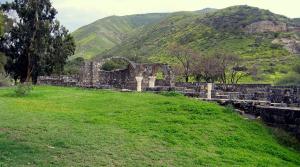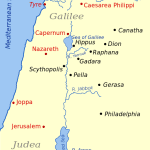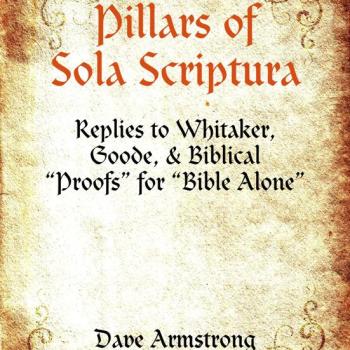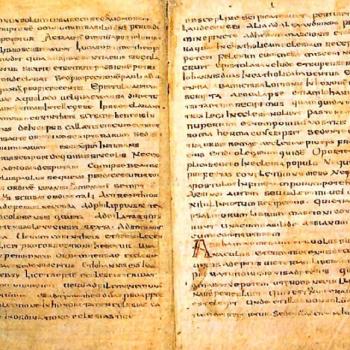Atheist anti-theist Jonathan M. S. Pearce is the main writer on the blog, A Tippling Philosopher. His “About” page from his former site states: “Pearce is a philosopher, author, blogger, public speaker and teacher from Hampshire in the UK. He specialises in philosophy of religion, but likes to turn his hand to science, psychology, politics and anything involved in investigating reality.”
He has encouraged me to visit his site and offer critiques. Before he departed his former site at Patheos, he wrote under a post dated 12-14-21: “I even need to thank the naysayers. Some of them have put up with a lot of robust pushback and still they come. Bravery or stupidity – it’s a fine line. But they are committed, and there is something to be said for taking that commitment into the lion’s den. Dave, you are welcome at my new place. Come challenge me. All the best to you and thanks for your critiques of my pieces. Sorry I couldn’t get to more of them.”
Again, at his new site (under a post dated 1-27-22), after a vicious attack by a commenter, calling for me and indeed all Christians to be banned, Jonathan offered an honorable and principled refusal: “I do welcome disagreements because I don’t want [my blog] to [be] just an echo chamber. As long as it is good faith . . . someone like Armstrong does give me ammunition for some of my pieces! As long as they aren’t trollish.”
His words below will be in blue, and guest writer Lex Lata’s in green.
*****
This particular debate has a long history:
Jonathan: “On Harmonising Biblical Contradictions” (7-23-17)
Me: Gadarenes, Gerasenes, Swine, & Atheist Skeptics [7-25-17]
Jonathan: “The Demons! The Demons! Replying to Armstrong on Biblical Contradictions” (7-29-17)
Me: Demons, Gadara, & Biblical Numbers (vs. JMS Pearce) [12-18-20]
Jonathan: [no further reply in writing, unless I missed something, in which case I’m sure he’ll let me know]
Now, Jonathan’s buddy “Lex Lata” has written the piece on Jonathan’s blog: “You say ‘Gerasa’ and I say ‘Gadara’: The case of the “obviously and demonstrably false” place name in the Gospels” (2-16-22)
The following is my reply to the latter.
***
Lex cites Church father Origen:
Now, Gerasa is a town [πόλις] of Arabia, and has near it neither sea nor lake. And the Evangelists would not have made a statement so obviously and demonstrably false . . . (Commentary on the Gospel of John, VI:24.) [italics removed]
Origen obviously regarded it (by alluding to “Greek copies”) as an illegitimate manuscript: a discussion that Christians have had for 2,000 years. This is a different argument than claiming a contradiction in a legitimate manuscript (i.e., in the actual Bible, as best we can determine it), as Jonathan and Lex do.
Origen would have been less than ecstatic, then, to learn that the discrepancy he lamented came to nest securely in the manuscript tradition and become canon:
They came to the other side of the sea, to the country of the Gerasenes. And when Jesus had stepped out of the boat, immediately there met him out of the tombs a man with an unclean spirit. Mark 5:1-2 (ESV).
Then they sailed to the country of the Gerasenes, which is opposite Galilee. When Jesus had stepped out on land, there met him a man from the city who had demons. Luke 8:26-27 (ESV).
And when he came to the other side, to the country of the Gadarenes, two demon-possessed men met him, coming out of the tombs, so fierce that no one could pass that way. Matthew 8:28 (ESV).
Since I’ve already dealt with this charge twice, readers (especially those who read those two articles) may perhaps forgive me if I cite some my existing research (I have a lot of new stuff, too, further below):
Smith’s Bible Dictionary . . .:
These three names are used indiscriminately to designate the place where Jesus healed two demoniacs. The first two are in the Authorized Version. (Matthew 8:28; Mark 5:1; Luke 8:26) . . . The miracle referred to took place, without doubt, near the town of Gergesa, the modern Kersa, close by the eastern shore of the Sea of Galilee, and hence in the country of Gergesenes. But as Gergesa was a small village, and little known, the evangelists, who wrote for more distant readers, spoke of the event as taking place in the country of the Gadarenes, so named from its largest city, Gadara; and this country included the country of the Gergesenes as a state includes a county.
We need to look up the Greek word for “country” in these passages, to see what latitude of meaning it has. In all three instances the word is chōra (Strong’s word #5561). Thayer’s Greek Lexicon defines it as “the space lying between two places or limits . . . region or country.” The Sea of Galilee was clearly one of the limits.
In Luke 2:8 it is applied to the city of Bethlehem; in Acts 18:23 to Galatia and Phrygia. In Mark 1:5 it is used of “the land of Judaea” (KJV) and in Acts 10:39,to “land of the Jews” (KJV). In Acts 8:1 we have the “regions of Judaea and Samaria” (KJV), and in Acts 16:6, Galatia alone. Thus it is not always used of one specific country (nation), but rather, usually to regions or areas of either small (Bethlehem) or large (Judaea and Samaria) size, including regions surrounding large cities.
Additionally, there is a linguistic argument to be brought to bear, that I will devote most of my energies to this time around:
Dr. Timothy McGrew persuasively argues that “country of the Gerasenes” refers not to Gerasa, but to the town of Kursi (which was in the region of Gadara). [Alleged Historical Errors in the Gospels, published online, 2012, pg. 52-53] He makes this argument based on the fact that the original Aramaic names for Gerasa and Kursi would have been spelled very similarly if not identically. Therefore, the identification with Gerasa is potentially due to an early copyist mistake or misinterpretation of Kursi.
Dr. McGrew’s theory is strongly supported by the geography of Kursi and early church history. Kursi is on the eastern shore of the Sea of Galilee and has a steep hill that runs directly into the water . . .
In addition, the early church, through the 3rd century church father Origen, identified Kursi as the town in which this miracle occurred. Further, an early 5th century Christian monastery was built in Kursi and seems to have been located there to commemorate this event. (“Busted (8): The Question of Jesus and the Demoniac” by Scott Dunkley, Logic & Light, 8-15-15)
He’s not the only one to note this. The Hebrew University of Jerusalem has a page devoted to an archaeological site of a monastery at least as old as the third century, at Kursi, near the Sea of Galilee (I visited the area myself in 2014). The monastery is described:
Identification:
The monastery uncovered at Kursi was identified as commemorating the “Miracle of the Swine” as described in the New Testament (Matt. 8, 28-34; Mark 5, 1-20; Luke 8, 26-39). The identification is mentioned by Origen in the third century (Commentaria in Joannem, 6.22).The small chapel located on the upper reaches of the monastery marks the location of the miracle. The large complex consisted of a large basilica, a monastery, a pilgrims’ hospice with a bathhouse and other installations. It was probably named for the miracle it commemorated.
And what does it give for the “site name?: “Kursi-Gerasa; Chorsia-Gergesa.” Note that this is a Jewish university making these linguistic equations, not the Protestant apologist (Dr. McGrew) or the Catholic one (myself). Go argue with them. There is a connection between Gerasa and Gergesa and the site of the alleged miracle at present-day Kursi. “Gergesenes” doesn’t appear in the RSV Bible that I use. It appears in the KJV (which has a different manuscript tradition behind it) at Matthew 8:28. But this is not without warrant, either, as we see from the Jewish site just noted, and as we will now see from two ancient and reputable sources.
Eusebius of Caesarea (260-313), the first great Church historian, in his Onomasticon: which was a gazetteer, listing place names with explanations of locations, wrote:
Gergesa. Where the Lord (Savior) heated the demoniacs (restored those vexed with demons to sanity). Now (today) a village is pointed out on the mountains near Lake Tiberias where the swine were condemned (cast down) to death. (Onomasticon, #363)
Origen himself (since Lex wanted to bring him up in this debate) — in the same section from which Lex made his citation — opts for Gergesa:
Gergesa, from which the name Gergesenes is taken, is an old town in the neighbourhood of the lake now called Tiberias, and on the edge of it there is a steep place abutting on the lake, from which it is pointed out that the swine were cast down by the demons. Now, the meaning of Gergesa is
dwelling of the casters-out,and it contains a prophetic reference to the conduct towards the Saviour of the citizens of those places, whobesought Him to depart out of their coasts.(Commentary on John, Book VI, sec. 24)
I visited this place in my trip to Israel in 2014. It has a dramatic cliff going down to the coast, but alas, not right on the water. Is this yet another “contradiction”? No. The texts, examined carefully, do not say that the pigs fell over the cliff into the sea, but that they ran down the cliff and then into the sea. Indeed, the cliff is shaped in a way that would allow them to do that (i.e., it’s not so steep that they couldn’t run down):
Matthew 8:32 (RSV) . . . the whole herd rushed down the steep bank into the sea, and perished in the waters.
Mark 5:13 . . . the herd, numbering about two thousand, rushed down the steep bank into the sea, and were drowned in the sea.
Luke 8:33 . . . and the herd rushed down the steep bank into the lake and were drowned.
Besides Dr. McGrew, others have argued that Gerasa (+ Gergesa?) are transliterations of Kursi:
Another possible resolution to the problem of the location of Gerasa has been proposed by Roger David Aus, who asserts that Gerasa may be a transliteration of Kursi . . . (Amanda Witmer, Jesus, the Galilean Exorcist: His Exorcisms in Social and Political Context [T&T Clark; 1st edition: April 26, 2012], 168; cf. further related reference on p. 183. Both pages were accessed through the “Look Inside” feature on Amazon; see it for much further context and linguistic argumentation from Aus)
Lee A. Maxwell, in his doctoral dissertation for Concordia Seminary (St. Louis): Gadara of the Decapolis (1 May 1980), also finds this explanation quite plausible:
It has been suggested that Gerasa should actually be read as Gergesa, under the assumption that Gergesa was not well known enough so that the more renowned Gerasa was inserted into the text. More probable, however, is that the two were simply alternative spellings of the same name. In pronunciation the consonants grs and grgs would have been easily confused. Consequently, only when one thought of the alternative Gerasa (viz., Gerasa of the Decapolis) would there have been a problem of identification.
The following question, however, arises: If this Gergesa/Gerasa is the correct designation, where was its location on the southern or eastern side of the Sea of Galilee? Some have avoided specification (and speculation) simply by affirming that it was somewhere along the southern or southeastern shore of the lake.” One suggestion has been that it was at Beth-yerah (modern Khirbet al-Kerak on the southwest corner of the lake).” The presence of swine, however, indicates that the party landed in Gentile territory, and the area around Beth-yerah (at least that part of it west of the Jordan River) was in Galilee, that is, in Jewish territory.
The other proposed location for the site of Gergesa/Gerasa is along the eastern shore of the Sea of Galilee near the Wadi as-Samak. For both topographical and toponymical reasons Tell al-Kursi on the south side of this wadi seems to be the most attractive option. Excavations there testify to the ancient tradition attached to the site. . . . the combination of geography and tradition renders Tell al-Kursi, or somewhere in the vicinity, probably the most logical candidate for the location of ancient Gergesa/Gerasa. (pp. 48-50)
Maxwell (on page 51) deems this explanation the most “probable” of the four possible explanations that he outlined. Surely, this is significant and can’t be dismissed, seeing (as I understand it) that the writer of a dissertation is supposed to know more than anyone else on the topic he or she chooses, as a result of all the copious research undertaken.
[W]e’ll . . . focus solely on the geographic predicament. Simply put, our scriptures link the same event to two different and noncontiguous communities. Contrary to the dutiful and not especially coherent harmonization efforts of some apologists, the archaeological and documentary evidence does not support the notion that “the country of the Gerasenes” somehow encompassed, or was more-or-less interchangeable with, “the country of the Gadarenes.”
Lex wants to equate the “Gerasa” under discussion with Jerash (Arabic: جرش Ǧaraš; Ancient Greek: Γέρασα Gérasa): the city now located in Jordan. But this is precisely what my linguistic argument undercuts. There were apparently at least two “Gerasa’s” in the Middle East in ancient times (a not uncommon occurrence, then or now). My argument above is that Gerasa should be understood as Kursi, which fits the scene of the biblical story to a tee (once the changing coastline of the Sea of Galilee is understood). If that is is or was indeed the case, then Jonathan’s and Lex’s argument collapses.
The Wikipedia article, “Gerasa (Judaea”) states: “Several attempts have been made to identify the Gerasa of Judea, the vast majority of scholars concurring that the ancient site is not to be confused with Gerasa (Jerash) of Transjordan, but with a site in Judea proper.” In the same article it’s also noted that the proposed sites in Israel are also a matter of controversy, and that Kursi is not even mentioned as one of the possibilities. But that’s where the linguistic and etymological argument comes in, which wasn’t touched by this particular article.
The Wikipedia article, “Kursi, Sea of Galilee” doesn’t address this argument, either, but on the other hand, neither does it rule it out. It needs to be addressed and shown to be implausible or improbable or erroneous if I am to be persuaded otherwise.
Archaeological Encyclopedia of the Holy Land (Avraham Negev and Shimon Gibson [New York and London: Continuum, 2003]) — not a Christian work –, in its article, “Kursi (Khirbet El-)” never mentions Jerash, and gives credence to my linguistic argument:
Located on the eastern shore of the Sea of Galilee, the name Kursi is thought to have originated from the name Gergesa and so it may be connected with the Land of the Gergesenes of the Gospels and the story of the stampeding Gadarene swine . . . (p. 286).
Likewise, in their article, “Gergesa” (p. 194) Negev and Gibson observe:
A place on the eastern shore of the Sea of Galilee, . . . where Jesus cast out devils (Matt. 8:28 ff.). The site was known by the name of Kursi in Jewish sources, . . . Origen and Eusebius (Onom. 73:14) mention a village by the name of Gergesai near the Lake of Tiberius, in which the swine drowned. The site is known today by the name of Kursi.
One of the big supposed “problems”, as Jonathan and Lex see it, is Matthew’s references to the Gadarenes. I submit, based on my arguments above, that they’ve already gotten the location of the “Gerasa” in question wrong, and now they’re contending that Gadara is too far away to be reasonably referred to. But Lex’s own comments betray this.
Gadara’s urban center was close enough to the Sea of Galilee for residents to view it at a distance.
His link provides a helpful photo for the reader to visualize how close it was to the Sea of Galilee. Consulting a Google Map for the coordinates provided in the Wikipedia article, “Gadara”, I see that it is exactly six miles away. Now, surely, after seeing what the word translated “country” in the three Gospel accounts can mean (which both sides of this discussion have addressed), this is within its parameters, so that Matthew was perfectly reasonable to describe the area as “the country of the Gadarenes” (both RSV and ESV).
Assuming for the sake of argument that Kursi is our place for the miracle, Gadara is a mere twelve miles from that, too, according to the same Google Map: easily within a day’s walk (that the ancients were well used-to and routinely capable of). Yet Jonathan and Lex would have us believe that it can’t possibly be the case that this region could rightly be called “the country of the Gadarenes” by Matthew? Of course it can! There is nothing implausible or forced or “rationalizing” about that. Kursi is also directly across the Sea of Galilee from Capernaum: precisely as Matthew stated (8:5, 18, 23, 28).
Here is Lex’s own treatment of the Greek for “country of” (complete with very impressive sources!):
The word χώρα (khora/chora) can mean country, region, land, hinterland, area, location, place, etc. Of course, context frequently determines the precise sense of a word, and in the context of Hellenistic city-states—our context here—χώρα also refers more specifically to the rural territory within the jurisdiction of a given city-state (πόλις, polis) outside the main urban center (ἄστυ, asty). (See B. Antela-Bernárdez, “Poleis, Choras and Spaces, from Civic to Royal: Spaces in the Cities Under Macedonian Rule from Alexander the Great to Seleucus I,” Pyrenae, vol. 47, no. 2 (2016), pp. 27-38; M.H. Hansen, ed., A Comparative Study of Thirty City-State Cultures (2000), p. 19; and “polis,” in S. Hornblower and A. Spawforth, eds., The Oxford Classical Dictionary (1996), p. 1205.)
Sure. Nothing is contrary to my scenario here. I’ve already made arguments for why the area could reasonably be called either “the country of the Gadarenes” or “the country of the Gerasenes” (Mark and Luke): since Geresa = Kursi (as my linguistic argument holds). It’s not a contradiction. Rather, it is the usual biblical non-contradictory complementarity.
Bearing this in mind, let’s turn to the χώρα within the political geography of the Decapolis. Take a few moments to look over the map on the second page of this chapter from Prof. Michael Eisenberg, a University of Haifa archaeologist who digs in the area. (We aren’t posting an image here for copyright reasons).
Gerasa’s χώρα did not extend to the Sea of Galilee. It did not even share a border with Gadara’s; the χώρα of Pella separated the two entirely. If a history teacher using this map asked me to put my finger on the country of the Gerasenes, and I pointed at the gray-brown patch around Gadara rather than the sienna patch around Gerasa, my teacher would justifiably doubt whether I was cut out for elementary map-reading.
But it’s the wrong Gerasa, which is the point. His premise is wrong. He goes on to say that his Gerasa (as opposed to Kursi / Gerasa) was less significant than Gadara at the time. He then “talks up” Gadara: which only supports my argument for why Matthew referred to it as the lead city of “the country” in this region:
To be sure, Gerasa’s economy and infrastructure experienced vibrant growth beginning especially in the latter part of the 1st century CE. But the same was true of its siblings throughout the Decapolis, including Gadara, during the Pax Romana. And Gadara was not some one-horse town easily lost in Gerasa’s long shadow. Scholars provisionally estimate Gadara’s population during this period to have been around 8,000, with Gerasa’s being not much larger, at roughly 10,000 (see W. Pierson, Spatial Assessments of Urban Growth in Cities of the Decapolis (2021), pp. 167, 170). Gadara produced noted poets and philosophers, boasted theaters and a hippodrome (like Gerasa), and warranted mentions from Pliny, Strabo, Josephus, and Ptolemy, among others (like Gerasa). (See S.T. Parker, “The Decapolis Reviewed,” Journal of Biblical Literature, vol. 94, no. 3 (1975), p. 437-441.) Gadara even minted its own silver coinage—unlike Gerasa and most other Decapolitan communities, whose mints appear not to have gone beyond bronze currency. (See A. Lichtenberger, “The Decapolis,” in T. Kaizer, ed., A Companion to the Hellenistic and Roman Near East (2022), p. 217.)
Prevailing in a debate becomes very easy when one’s opponent is partially making one’s argument. Thanks! All those resources are most helpful for strengthening my own case. Saves me a lot of work . . .
Second, and more significantly, any notion of Gerasene reputational prominence didn’t warrant even a mention by Origen, our best ancient source to consider the Gerasa/Gadara problem. He had his hands on some of the earliest Gospel papyri, spoke and wrote Koine Greek with native fluency, lived in Roman Palestine a little over a century after the Gospels were composed, and traveled extensively throughout the area to teach, collect important manuscripts, and trace JC’s footsteps as best he could. He literally talked the talk and walked the walk. If Gadarene territory might reasonably and correctly have been called the land of the Gerasenes in the Greek usage of the time—for whatever reason—we should expect Origen to have told us that, or to have stayed silent about a non-issue.
First of all, he (like Eusebius) equated Gergesa with what we know as Kursi today.
Secondly, that’s not the Christian argument, anyway (straw men abound!). We’re not equating “Gerasene” and “Gadarene” (which would indeed be a contradiction). We’re saying (following Origen and Eusebius and deducing a bit more) that Gerasa = Gergesa = Kursi and that the region around Kursi could reasonably be described as either “the country of the Gadarenes” (more regional, like a county) or “the country of the Gerasenes” (a local reference, to the town), just as I could say that I live “in the country / area / region of Lenawee County [Michigan]” or that I live “in the country / area / region of Tecumseh“: my current town, which happens to have a population of 8,000 or so just as ancient Gadara did.
I can also refer to the location of my residence as “southeast Michigan” [i.e., in the Lower Peninsula] or “the Irish Hills region of Michigan, which is another (colorful and delightful) place name in this area. If I were closer to Detroit, I could also say “suburb of Detroit” or “metro Detroit.” What is so difficult to understand about permissible alternate names for a region? We do it all the time. So did the ancients. Lex can do the same for wherever he lives in Minnesota. And Jonathan can do it in England / the UK / Great Britain, which is in the British Isles and western (but not continental) Europe. Lots o’ place names exist, and overlapping and non-contradictory ones.
But he did neither. Quite the opposite. Origen dismissed the nomenclature as “obviously and demonstrably false” (“προφανὲς ψεῦδος καὶ εὐέλεγκτον”).
Yes, because he was referring to the Gerasa in Transjordan. What is now known as Kursi, he called Gergesa, as Eusebius also did. As Maxwell noted in his dissertation on Gadara (cited above), “In pronunciation the consonants grs and grgs would have been easily confused.” Origen’s Commentary on John was written between 226-229. Eusebius’ Church History dates from 326. That’s pretty early attestation. “Gergesenes” (from the same root) appeared in the KJV at Matthew 8:28.
The King James Version used the Textus Receptus, which is based on Greek manuscript of very ancient pedigree, but not the oldest ones (which are followed by most modern versions). The question of preferability of Bible manuscripts is an extraordinarily complex issue. See, for example, the lengthy article, “Text of the Gospels” in Hastings’ Dictionary of the New Testament (five volumes: 1904). But there have been several new developments in the understanding of the most accurate manuscripts in the 118 years since that article.
The five-volume Expositor’s Greek Testament from 1897 already pretty much figured out (based on recent archaeological discovery) what is now my preferred argument, 125 years ago, in its commentary on Matthew 8:28-34:
[S]ince the discovery by Thomson (Land and Book, ii. 374) of a place called Gersa or Kersa, near the eastern shore of the lake, there has been a growing consensus of opinion in favour of Gerasa (not to be confounded with Gerasa in Gilead, twenty miles east of the Jordan) as the true name of the scene of the story. A place near the sea seems to be demanded by the circumstances, and Gadara on the Hieromax was too far distant. . . .
Prof. G. A. Smith, Historical Geography, p. 459, note, pronounces Gerasa “impossible”. But he means Gerasa in Decapolis, thirty-six miles away. He accepts Khersa, which he identifies with Gergesa, as the scene of the incident, stating that it is the only place on the east coast where the steep hills come down to the shore.
Likewise, Cambridge Bible for Schools and Colleges, in its commentary on Matthew 8:28-34, which was written in 1893, states in concurrence:
The readings vary between Gerasenes, Gadarenes and Gergesenes. Gerasa and Gergesa are forms of the same name. Gadara was some distance to the south of the Lake. It was, however, the capital of Peræa, and the more important place; possibly Gergesa was under its jurisdiction. Gergesa is identified with the modern Khersa; in the neighbourhood of which “rocks with caves in them very suitable for tombs, a verdant sward with bulbous roots on which the swine might feed” (Macgregor, Rob Roy), and a steep descent to the verge of the Lake, exactly correspond with the circumstances of the miracle.
The Pulpit Commentary, from the 1890s, also agrees with this general scenario, in its commentary on the same verses:
Verse 28. – And when he was come to the other side into the country of the Gergesenes; Revised Version, Gadarenes, which is certainly right here, as is “Gerasenes” in the parallel passages (cf. Westcott and Hort, it. ‘App.’). Gergesa (Textus Receptus here, and Alexandrian authorities in parallel passages) and Gerasa (unless, with Origen on John 1:28, we understand by this the Arabian Gerasa fifty miles away)are probably forms of the same name now represented by Khersa, a village discovered (? in 1857) by Thomson (‘The Land and the Book,’ pp. 375, sqq., edit. 1880) on the eastern side of the lake, and lying “within a few rods of the shore,” with “an immense mountain” rising directly above it, “in which are ancient tombs, out of some of which the two men possessed of the devils may have issued to meet Jesus. The lake is so near the base of the mountain that the swine, rushing madly down it, could not stop, but would be hurried on into the water and drowned.”
So why do the Gospels of Mark and Luke refer to “τὴν χώραν τῶν Γερασηνῶν” rather than “τὴν χώραν τῶν Γαδαρηνῶν?” Dunno. We have little basis for any confident conclusions.
That’s odd. There are perfectly plausible, reasonable explanations for it.
. . . a lakeside area was confusingly and inaccurately given the name of a landlocked community one or two days to the southeast.
Not if there were two places named Gerasa, and one was indeed by the Sea of Galilee.
To be clear, I don’t expect the fuss about a place name in a spectacular exorcism story to deal a stunning blow to anyone’s faith. By itself, this is a mere foot fault in the broader context of the New Testament. Nor is it my position that the Gerasene difficulty must mean the Gospels and other books of the Bible are unusually defective with regards to geography. On the contrary, I think they get a good deal of that stuff right, roughly on par with many analogous texts from antiquity.
This is good and fair-minded, unlike so much of online atheist rhetoric of the anti-theist variety, which is insulting and condescending. This is why it’s a true pleasure to dialogue with Lex. He exhibits not one trace of those ethical and intellectual shortcomings. He also — refreshingly — understands that these arguments of mine are not “personal” at all. Not one bit. It’s all addressed to the weakness of premises and arguments.
I discuss this misidentification simply to illuminate one notable example of human error creeping into canonical holy writ that many believers of a fundamentalist bent tell us is inerrant. Origen discerned the problem of the Gerasenes firsthand nearly two millennia ago. We see it still today. And the inaccuracy cannot be convincingly cured by any amount of ad hoc apologetics.
And I beg to profoundly differ. I’ve dealt with this paper and two previous ones by Jonathan. Jonathan wrote under Lex’s article today:
[We] have 3 written pieces and a video. Deal with them or don’t. . . .There are arguments and you need to deal with them and that’s the end.
I dealt with all three (this one being produced within 24 hours of Lex’s article). I don’t deal with videos, only written material, for several reasons. So I’ve held up my end. The question is whether Lex and/or Jonathan will counter-reply to this and whether Jonathan will rebut my second reply to him.
Three meaty articles from me [a total of about 9,300 words or roughly 33 standard pages] just about the Gadarenes / Gerasenes supposed contradiction are quite sufficient to adequately cover the topic. I have a lot to write about as an apologist. But I will reply again if they come up with anything different from what I’ve already dealt with, and especially if they take on my arguments directly (a true dialogical counter-response), as I have, theirs. There is no need to repeat myself when these three articles are published on my blog for one and all to read.
[Note: I did reply a fourth time and came up with several new arguments: Pearce’s Potshots #63: Lex, NT Texts, & the Next Town Over (2-28-22).]
***
Practical Matters: Perhaps some of my 4,000+ free online articles (the most comprehensive “one-stop” Catholic apologetics site) or fifty books have helped you (by God’s grace) to decide to become Catholic or to return to the Church, or better understand some doctrines and why we believe them.
Or you may believe my work is worthy to support for the purpose of apologetics and evangelism in general. If so, please seriously consider a much-needed financial contribution. I’m always in need of more funds: especially monthly support. “The laborer is worthy of his wages” (1 Tim 5:18, NKJV). 1 December 2021 was my 20th anniversary as a full-time Catholic apologist, and February 2022 marked the 25th anniversary of my blog.
PayPal donations are the easiest: just send to my email address: [email protected]. You’ll see the term “Catholic Used Book Service”, which is my old side-business. To learn about the different methods of contributing, including 100% tax deduction, etc., see my page: About Catholic Apologist Dave Armstrong / Donation Information. Thanks a million from the bottom of my heart!
***
Photo credit: Talmoryair (3-10-09). Present-day Kursi, Israel (= Gerasa = Gergesa) on the eastern shore of the Sea of Galilee, where Jesus healed the two demoniacs. [Wikimedia Commons / Creative Commons Attribution 3.0 Unported license]
***
Summary: This is my third rebuttal of atheists’ use of the tired “Gadarenes & Gerasenes” alleged biblical contradiction and “problem”: with several new resources introduced.
***














